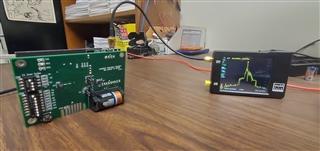So, I'm using a CC1120 for almost an exact copy custom circuit board of the CC112xEM TI demo board at 434MHZ. However, I'm using 0805 parts (resistors, caps, inductors) to make it easier for engineers to manufacture some prototype boards. I'm seeing decent results on signal strength, but I'm trying to get it closer to the TI numbers I'm seeing, if possible. The schematics of the boards are exactly the same. The layouts, because of the size of the parts is not exact, but pretty close. But, that pretty close might not be good enough. I'm trying to get the impedance down in the 50 ohm range, but currently it's around 70.
If I have 2 TI demo boards (TrxEB) exchanging packets from about 4 feet away, I get -15 to -18db signal almost every time. That's really good for our application. I have tweaked our custom board to where it gets -25 to -28db, but I'm trying to do better.
Our stackup was slightly different with a 20 mils substrate. The TI board had 10 mils. So, we adjusted that down to 10 mils, but that made the signals much worse. So, we went back to 20 mils and made some slight adjustments to the part placement on the TX and RX lines to the antenna to come down on the impedance. We are waiting on those prototype boards to come back.
So, I have some questions regarding other alternatives to try and some for feedback.
1. Are the 0805 parts on the RX and TX lines that susceptible to that big of a signal difference from the 0402s, everything else being the same?
2. Would it be a good experiment to try 0603s just on the RX and TX lines to see if there is any improvement? I think our techs should be able to put those down without any new equipment. 0402s would be a little tough.
3. Why would going from a 20 mil substrate down to 10 like the TI demo board cause such a much worse performance, everything else being the same?
4. Would it be helpful to send layout files for both the TI demo board and our board for others to see what improvements might be suggested? The layout of the TI board is online, however.
Thanks in advance.
Sutton


